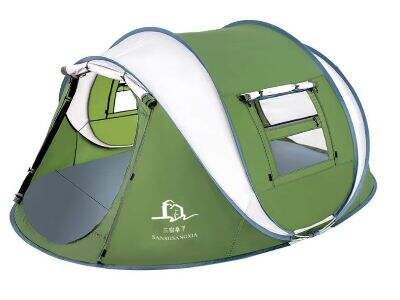In camping, the form of your tent is more important than you’d think. Ever wonder why some tents are shaped like domes while others are in the form of a geodesic? Well, guess what, your tent shape actually can make a big difference in stability, especially in bad weather. We're going to look at the science between the 2 designs of geodesic vs. dome tents and see which one comes out on top.
Effects of shape on the stability of structure
Picture the building of a tent with sticks and blankets. Just imagine if you stacked the sticks with any old random placement, the tent would have already blown down by now. But if you take care to arrange the sticks in a dome, the tent becomes far more stable. The weight on such a structure is spread evenly across its curved or domed surface, and so one isn’t likely to cave in.
Geodesic tents, like one above, go a step further in stability by interconnecting their poles to form a mesh of triangles. These triangles combine to spread stress throughout the tent and help to make geodesic tents incredibly stable. So if you’re in the backcountry being battered by wind or rain, a geodesic tent is your best bet to weather the storm and remain dry.
Tent shape in severe weather situations
The most severe weather can test even the hardiest of tents. From high winds to heavy snow, Mother Nature doesn’t mess around when it’s time to put your camping gear to the test. This is where your tent’s design can come in handy.
Reasoning: With its aerodynamic shape, dome tents are highly snow resistant and windworthy. The Naturally, the domed outside walls of this type of tent encourage snow to slid off and keep it from building up and weighing down the walls. Furthermore, the wind clears the aerodynamic shape of the dome tent, which helps in preventing the tent structure from collapsing due to wind.
In contrast, Geodesic tents are great for withstanding severe conditions. The joined poles form a sturdy, reliable skeleton capable of handling the most extreme weather - from driving snow to the strongest winds. That means if you’re planning a winter camping trip, or if you’ll be camping in windy conditions, a geodesic tent is your best choice for staying safe and warm.
Which shape reigns supreme?
So what’s the ultimate design when it comes to a tent shape? Geodesic or dome tent Both geodesic and dome tent have their advantages, but it ultimately comes down to what you will be using the tent for. If you want a tent you can take most anywhere and one that can be used in any conditions, choose a geodesic tent. Durable in design and easy to use in the toughest of weather conditions, this is a dependable option for all kinds of campers.
However, if you're looking for something that's easy to set up and transport, you may be better off with a dome tent. Dome tents are nothing heavy and easy to carry, and hence these are the ideal tents for campers and even for people who are out on a backpacking trip. Remember, while they are great, dome tents could be unstable when it gets really rough outside.
Why the size and shape of your tent really matters when it comes to comfortable camping
The form of your tent has a lot to do with your camping experience. Try to sleep through a storm in a shitty tent that’s barely wind resistant, is what I’m saying. You’ll be miserable, and at risk of the tent falling on top of you.
The shape of the tent really does matter when it comes to having a good time camping. Whether you’re camping in the mountains or on the beach, only a sturdy, reliable tent will ensure your well-earned rest at night. So before setting off on your next adventure, stop and think about the shape of your tent and how it is going to stand up to the weather.
The science of geodesic and dome tents explained
Geodesic and dome tent camping may appear similar, but they have different engineering behind them. Geodesic tents are based on a system of intersecting poles, which creates a force that supports the frame for the tent, whilst dome tents are based on a simple curved shape, supporting the tent.
The secret to geodesic tents is the power of triangles. With its triangular shapes formed by connecting poles, geodesic tents can distribute stress and tension fairly evenly, allowing them to be very strong. For this reason, geodesic tents can often be found in harsh weather environments where strength is a must.
Dome tents, meanwhile, depend on the inherent strength of curves. The swooping walls of a dome tent help spread out weight and shrug off snow and rain. Dome tents such as these easy to use dome tents make camping simple and fun.


